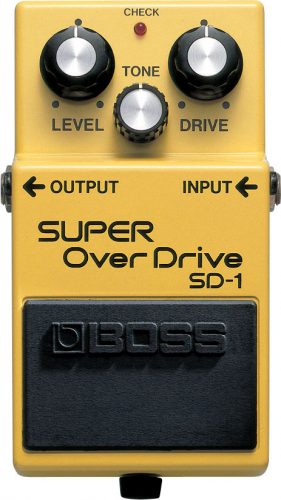You can switch from clean to distortion effects through various ways like channel switcher, gain pedals or just simply using the guitar volume knob.
It mostly depends on the rig you have and your preference on the result. In this article I will share 5 ways to switch from clean to distortion fast. I remember asking questions like these when I just started out.
Now that I know how to do them, I figured it would make a helpful article. I will also cover how popular bands like Metallica switch out their tones so quickly. Hint: they have additional help.
5 ways To Switch From Clean To Distortion Fast (Vice Versa)
1. Use gain pedal
With gain pedals, you can quickly switch from clean to distortion very quickly using the footswitch – where you push on it with your foot.
When using gain pedals, I recommend tuning your amp settings for a clean sound and then connecting it to the gain pedal.
When you need to play with a clean sound, make sure the gain pedal is off. When you need to switch to distortion, push the gain pedal using your foot to turn it on – which changes the sound to distortion immediately.
Keep in mind that sound changes the moment you push the pedal with your foot. So, if you need longer sustain, you may need to wait a bit or use other pedals like a delay pedal.
Overdrive, distortion and fuzz pedals are just different types of gain pedals – mainly to create distortion effects.
Personally, I recommend getting an overdrive pedal (instead of distortion or fuzz) – it’s the least intense and will give you the brighter distortion without being too dirty.

2. Switch amp channel with foot switcher
If your amp supports multiple channels, you can quickly change from clean tone to distortion using a foot switcher.
For this, you need to connect a foot switcher into the ‘footswitch’ input jack on your amp and push on the footswitch to change from clean to dirty channel.
Note that a footswitch is usually separately purchased from the amp. They range from $20 to even $100 from the popular brands – of course, the more expensive ones have more features and are built better.
Here’s a review of the Boss FS-6 footswitch ($70 from Amazon). It allows you to switch channels on an amp and also a couple of other things.
If you don’t have the budget to get a footswitch, you can also create it yourself. It’s surprisingly quite simple and DIY footswitch for amp channels is very common. Here’s a YouTube video showing you how to build one.
Cheaper amps typically only have 1 clean channel – which means you cannot switch easily while in a song.
If your amp only has 1 channel, then you need to get either an overdrive or distortion pedal to easily switch while in a song.
3. Adjust volume control
Volume knob on your guitar can be used to reduce the amount of distortion because the volume knob controls how much signal is passing through.
To do this, you need to set up your amp to play distorted sounds. Make sure the volume knobs on your guitar are all the way up.
When you need to go back to cleaner tones while playing, you can roll back the volume knob on your guitar and watch the distortion effect get reduced. Roll the knob until the tone gets as clean as you want.
This method works fairly well if you are at home and just want to practice without any audience. Don’t expect a crunchy distortion and a super clean tone – this is more like a hack.
This option is best if you don’t want to spend on a pedal and your amp only has one channel.
4. Use pickup switcher
If your guitar has separate volume control for each pickup, then you can have the neck pickup at highest volume for distortion and bridge pickup at much lower volume for clean sound.
With this setup, you can use the pickup switcher on your guitar to switch between high volume distorted sound or low volume clean sound – almost like a footswitch on a multi-channel amp.
I recommend using the bridge pickup as the clean one because bridge pickup already gives you brighter and cleaner sound by default. This should be more suitable for the clean sound.
Whereas neck pickup is warmer and darker – more suitable for dirty and heavier distortion sound.
Example of guitar with independent volume control for each pickup is the Squier Telecaster Custom.
5. Control the power you use to pluck strings
You can switch between clean and distortion by controlling how hard you pluck the strings. Pluck the string hard for distortion and pluck it soft for clean sound.
Generally, the harder you pluck, the more distorted the sound gets. Knowing this, you can control whether to get a distorted sound or not.
Obviously the amp settings must be set to dirty distortion first. Then try plucking the guitar softly to see it produces a cleaner sound.
Jump to 1:32 to see the guitarist shows you exactly what I am talking about
How Metallica Switch From Clean To Distortion Quickly
Popular bands like Metallica and Slipknot can easily switch from clean to distortion without any pedal because they have a team of tech backstage that handles it!
Which means, the musicians in these bands don’t manually switch the tone. Instead, it’s all left to a team of tech backstage. They have practiced and choreographed it many times before the actual performance.
So if you think they are super humans that can switch extremely fast – they are not. You need a full team of tech to help them out!
My Recommended Way To Switch From Clean To Distortion
To get the best experience, I recommend switching from clean to distortion using a dedicated pedal. Each pedal provides a unique sound and they usually sound much better than an amp.
It’s pretty common for a guitarist to have multiple pedals to achieve their sound effects. Distortion is not the only thing you can do and you shouldn’t limit yourself.
If you don’t have the budget for new pedals today, I recommend trying to switch from clean to distortion by controlling your plucking power.
Pluck the strings softly for cleaner sound and pluck it hard for distortion. I am sure you can get used to it fairly quickly.





